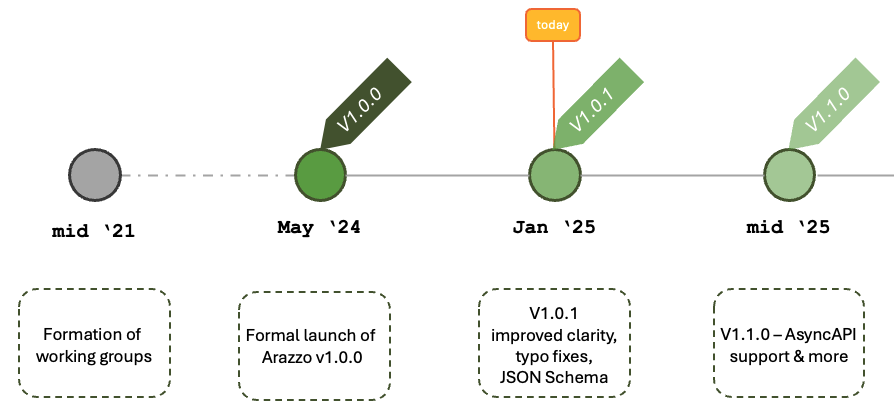Welcome to the OpenAPI Initiative (OAI) April 2025 newsletter! Our newsletter brings you initiative news, details of new versions of our specifications, and information on events and educational resources.
Initiative News
We’d like to take the opportunity to issue a call to action in our Initiative News section!
We are currently pursuing multiple version lines with v3.2 coming together and Moonwalk deep-diving into the future of the OpenAPI Specification. The project and TSC members especially, are doing a great job in developing the OpenAPI Specification ready for the next challenges an AI-enabled world will bring. We, the OAI, would love to see increased OpenAPI v3.1 adoption! v3.1 brings benefits that will act as a solid foundation for the future development of the OpenAPI Specification, especially with v3.2, and for API providers brings new features and capabilities.
Think of especially important use cases, like presenting conditional objects in open banking or open finance APIs, or providing a true and accurate representation of a JSON Web Token. You’ll quickly find that v3.1 could almost certainly help you. If you are using tooling that you pay for from a software vendor, ask them about their v3.1 upgrade plans today! Please also visit our existing post that provides valuable resources that will help you with your implementation of v3.1.
In other initiative news, Arazzo Specification is currently planning a version 1.0.2 and v1.1.0 later this year. Arazzo adoption continues to grow with tools like Symplr bringing great tools to the ecosystem, and the OAK Repository, which we cover in more detail in our Ecosystem Spotlight section.
Events News
Our conference agenda for the year is well underway! The next appearance of the OAI Track will be at Apidays New York, where Erik Wilde will host insightful sessions on API governance, the role of OpenAPI with generative AI apps, bringing OpenAPI and AsyncAPI together, and a host of other sessions. The Apidays New York strapline is “No AI Without API Management” and will be covering the intersection between AI and APIs. Apidays New York will also feature the Travel Tech API Conference, where OAI Outreach Chair Stu Waldron will feature on an agenda dedicated to travel.
Erik and Frank Kilcommins are also hosting the OAI Track later this year at API:World, the world’s largest and longest-running API and microservices event. APIs leveraging specifications like OpenAPI and Arazzo act as the best canonical knowledge source as we step into the AI-augmented future. If you have an opinion on how these formats can help return on AI investments, then make sure to apply for the track! The call for speakers is still open so if you’d like to join Erik and Frank on stage in Santa Clara please follow the event page link and click on the CFP link.
The event’s roster for 2025 is constantly updated, so please stay in touch with our Events page to see where you can get together with OpenAPI community members for in-person and virtual events.
Ecosystem Spotlight
We are now welcoming highlights from community members who are making a contribution to the ecosystem beyond the core specifications.
The Open Agentic Knowledge (OAK) Repository is one such project. The goal of OAK is to leverage existing OpenAPI and Arazzo description documents to create AI-consumable descriptions that provide intent-orientated workflows. The Repository is now hosting a significant number of descriptions, with over 100 Arazzo descriptions, like the largest collection available at the time of writing.
Thanks to Sean Blanchard for highlighting this work. Sean describes OAK as follows: “MCP might be someone’s preferred transport, but OpenAPI/Arazzo should be the schema. We are particularly excited about converting the whole repository to OpenAPI 4.0.” Identifying and evolving key intersections, such as OAK, for the growth of AI-powered ecosystems is vital for leveraging all the important work that has gone into bringing the OpenAPI and Arazzo specifications to life. Moreover, as Frank Kilcommins describes it “Open standards like OAK ensure interoperability and reduce fragmentation”.
We excitedly await the future development of OAK.
If you’d like your project covered in a future newsletter please let us know by getting in touch on Slack.
Finally…
Thank you for reading our newsletter. As always, we welcome suggestions on how we can improve it or bring you information that can help make the most of how you use specifications published by the OpenAPI Initiative. Please get in touch on the Outreach channel on Slack if you would like to work with us to tell your story, to feature in the Ecosystem Spotlight section, or get involved with any of the initiatives described above.
Author: Chris Wood

